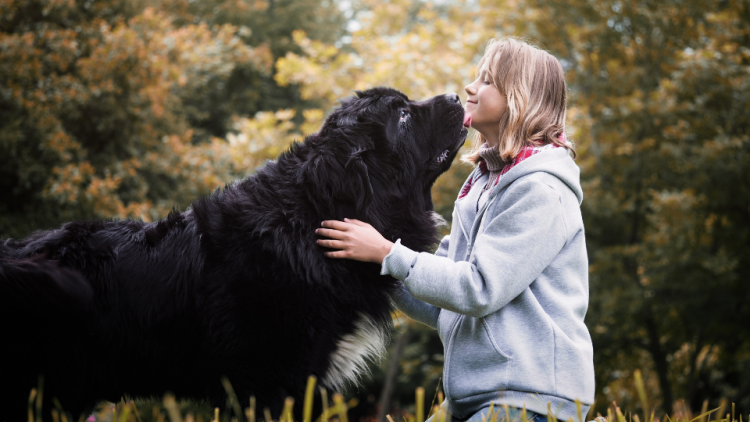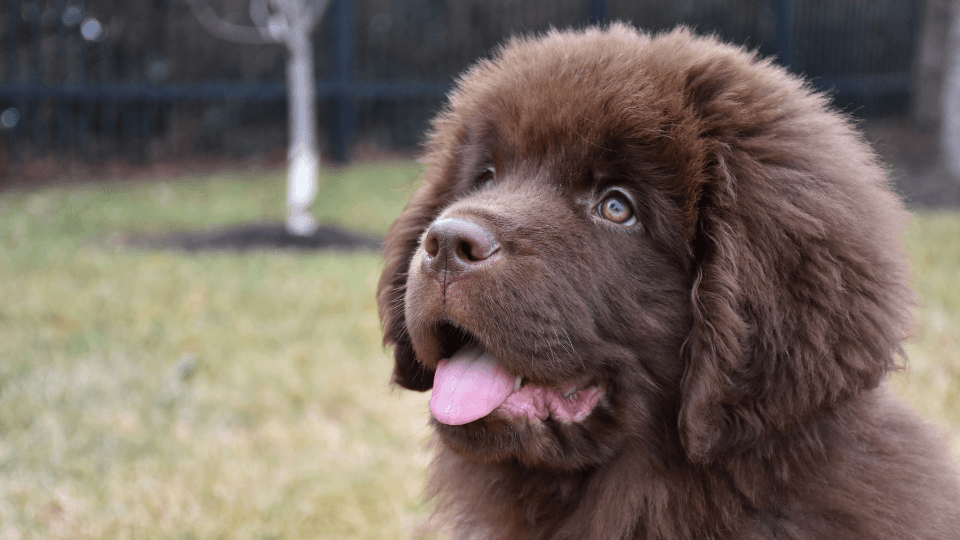Famous for their giant size and charming personality, Newfoundlands, otherwise known as Newfies or Newfs, are powerful working dogs. Bred initially as water rescue dogs, Newfies were the Saint Bernards of the water and rescued many men from drowning in the icy North Atlantic waters.
If you’re the lucky pet parent to one of these loving giants, you may be asking yourself how big do Newfoundland dogs get and when will they stop growing? Our Newfoundland growth chart will show you estimates of your pup’s weight at each stage in their development.
Here’s everything you need to know about Newfoundland weight, size, and growth rate:
- Newfoundland Growth & Weight Chart
- At what age is a Newfoundland fully grown?
- How big should a 6-month-old Newfoundland be?
- How much bigger will my Newfoundland get?
- What is the size of a full-grown Newfoundland dog?
- How do I make sure my Newfoundland is healthy?
- Key Takeaways
Newfoundland Growth & Weight Chart
| Age | Male Weight (lb) | Female Weight (lb) | Height (in) |
|---|---|---|---|
| 1 month old | 8 - 12 | 7 - 11 | 10 - 12 |
| 2 months old | 17 - 27 | 15 - 22 | 13 - 14 |
| 3 months old | 41 - 54 | 38 - 46 | 19 - 21 |
| 4 months old | 55 - 65 | 45 - 56 | 20 - 23 |
| 5 months old | 63 - 75 | 54 - 67 | 21 - 24 |
| 6 months old | 73 - 87 | 59 - 72 | 22 - 24 |
| 7 months old | 82 - 98 | 66 - 75 | 22 - 25 |
| 8 months old | 92 - 101 | 69 - 78 | 23 - 25 |
| 9 months old | 102 - 115 | 75 - 84 | 23 - 25 |
| 10 months old | 109 - 121 | 84 - 95 | 24 - 26 |
| 11 months old | 112 - 128 | 92 - 106 | 24 - 26 |
| 12 months old | 114 - 130 | 92 - 110 | 24 - 27 |
| 2 years old | 130 - 150 | 100 - 120 | 26 - 28 |
Please keep in mind that the above numbers in our Newfoundland weight chart are estimates and that all puppies will grow at their own pace.
As giant dogs, Newfoundlands take longer to reach their full size than most other breeds. If your pup is significantly behind or ahead of the above numbers, consult with your veterinarian to make sure they are growing appropriately.
Pro Tip: Compare options for dog health insurance to get peace of mind knowing your Newfoundland puppy has access to gold-standard care for life.
At what age is a Newfoundland fully grown?
As a giant breed, Newfoundlands take more time to reach their full size compared to smaller canines. Most do not reach the mature height and weight of a Newfoundland dog until about two years old.
How big should a 6-month-old Newfoundland be?
All Newfoundland puppies will grow at their own pace. However, you can expect a six-month-old Newfoundland puppy to be around 22 to 24 inches tall.
On average, male Newfoundlands weigh around 73 to 87 pounds at six months old. Comparatively, six-month-old female Newfoundlands weigh slightly less at 59 to 72 pounds.
Pro Tip: Download our new puppy checklist that details how to set up a vaccination schedule, preventive care routine, fundamental puppy training, and more.
How much bigger will my Newfoundland get?
There are a few ways to estimate how much bigger your Newfoundland puppy will get.
- Age. If your Newfie pup is less than a year old, they have significant growing left to do. If they are between a year and two years old, they are likely still filling out their chest. After two years, your Newfoundland puppy should be at their adult size.
- Paws. Next, take a look at your Newfoundland’s paws. If their paws look oversized next to their body and legs, they are probably still growing, as this is a classic puppy feature indicating they are still filling out.
- Genetics. Lastly, if you purchased your Newf from a breeder, reach out to them for a more precise estimate of your Newf’s adult size. Based on your Newfoundland’s parents and past litters, your breeder should be able to provide you with a more accurate estimate of how big your pup will grow.
What is the size of a full-grown Newfoundland dog?
According to the American Kennel Club (AKC) official breed standards, the Newfoundland dog weight in males should be between 130 to 150 pounds, while females should weigh between 100 and 120 pounds.
Male Newfs should also be slightly taller, near 28 inches tall, while female Newfs should stand at about 26 inches. Both male and female Newfies will be heavy boned and carry themselves with a sense of dignity.

How do I make sure my Newfoundland is healthy?
As purebred dogs, Newfoundlands are at a heightened risk of genetic health problems. While this can be heartbreaking to think about as loving Newfie parents, there are several things we can do now to help our Newfie have a healthy and happy life. The most crucial step is providing our Newfoundlands with routine veterinary care.
Newfoundlands are particularly prone to skeletal issues, hip dysplasia, wobbler syndrome, cataracts, and aortic stenosis. Wobbler syndrome affects large and giant dog breeds, like the Newfoundland, at a higher rate and can lead to a wobbly gait in mild cases of paralysis in severe cases. In most cases, surgery is required to relieve pressure on the spinal cord, after which the prognosis is usually favorable.
Newfoundland Veterinary Costs
While veterinary advances allow pets to receive treatment more effectively, the rising costs of veterinary care make these treatments inaccessible for some pet parents. Many veterinary procedures can easily cost thousands of dollars. For example, the cost of hip dysplasia surgery for dogs ranges from $1,200 to $7,000 per affected hip. If both hips are affected, surgery can cost up to $14,000. These numbers are startling, but a dog may become lame and experience incredible discomfort without this surgery.
Pet insurance acts as a safety net should an expensive vet bill arise unexpectedly. If your Newfoundland gets hurt or falls ill, a pet insurance policy can provide reimbursement for up to 100% of eligible, out-of-pocket veterinary expenses. Wellness plans are also available to help you with the cost of routine care, reimburse your puppy’s weight, including dog x-rays, dental cleanings, and more.
Key Takeaways:
- According to the AKC, the mature Newfoundland dog weight is 130-150 pounds (male) or 100-120 pounds (female).
- Our Newfoundland growth chart estimates the weight of your puppy until they stop growing around two years of age.
- As a breed, Newfoundlands are more susceptible to various hereditary conditions, such as hip dysplasia and wobbler syndrome.
- Pet insurance can protect your puppy and give you a financial safety net for veterinary expenses throughout their life.
